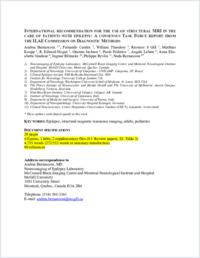Recommendations for the use of structural magnetic resonance imaging in the care of patients with epilepsy: A consensus report from the International League Against Epilepsy Neuroimaging Task Force.
- Bernasconi A Neuroimaging of Epilepsy Laboratory, McConnell Brain Imaging Centre, Montreal Neurological Institute and Hospital, McGill University, Montreal, Quebec, Canada.
- Cendes F Department of Neurology, University of Campinas, Campinas, Brazil.
- Theodore WH Clinical Epilepsy Section, National Institutes of Health, Bethesda, Maryland.
- Gill RS Neuroimaging of Epilepsy Laboratory, McConnell Brain Imaging Centre, Montreal Neurological Institute and Hospital, McGill University, Montreal, Quebec, Canada.
- Koepp MJ Institute for Neurology, University College London, London, UK.
- Hogan RE Department of Neurology, Washington University School of Medicine, St Louis, Missouri.
- Jackson GD Florey Institute of Neuroscience and Mental Health, University of Melbourne, Heidelberg, Victoria, Australia.
- Federico P Hotchkiss Brain Institute, University of Calgary, Calgary, Alberta, Canada.
- Labate A Institute of Neurology, University of Catanzaro, Catanzaro, Italy.
- Vaudano AE Neurology Unit, Azienda Ospedaliero Universitaria, University of Modena and Reggio Emilia, Modena, Italy.
- Blümcke I Department of Neuropathology, University Hospital Erlangen, Erlangen, Germany.
- Ryvlin P Clinical Neurosciences, Lausanne University Hospital, Lausanne, Switzerland.
- Bernasconi N Neuroimaging of Epilepsy Laboratory, McConnell Brain Imaging Centre, Montreal Neurological Institute and Hospital, McGill University, Montreal, Quebec, Canada.
- 2019-05-29
Published in:
- Epilepsia. - 2019
adults
epilepsy
pediatrics
structural magnetic resonance imaging
Adult
Advisory Committees
Child
Consensus
Epilepsy
Humans
Magnetic Resonance Imaging
Neuroimaging
English
Structural magnetic resonance imaging (MRI) is of fundamental importance to the diagnosis and treatment of epilepsy, particularly when surgery is being considered. Despite previous recommendations and guidelines, practices for the use of MRI are variable worldwide and may not harness the full potential of recent technological advances for the benefit of people with epilepsy. The International League Against Epilepsy Diagnostic Methods Commission has thus charged the 2013-2017 Neuroimaging Task Force to develop a set of recommendations addressing the following questions: (1) Who should have an MRI? (2) What are the minimum requirements for an MRI epilepsy protocol? (3) How should magnetic resonance (MR) images be evaluated? (4) How to optimize lesion detection? These recommendations target clinicians in established epilepsy centers and neurologists in general/district hospitals. They endorse routine structural imaging in new onset generalized and focal epilepsy alike and describe the range of situations when detailed assessment is indicated. The Neuroimaging Task Force identified a set of sequences, with three-dimensional acquisitions at its core, the harmonized neuroimaging of epilepsy structural sequences-HARNESS-MRI protocol. As these sequences are available on most MR scanners, the HARNESS-MRI protocol is generalizable, regardless of the clinical setting and country. The Neuroimaging Task Force also endorses the use of computer-aided image postprocessing methods to provide an objective account of an individual's brain anatomy and pathology. By discussing the breadth and depth of scope of MRI, this report emphasizes the unique role of this noninvasive investigation in the care of people with epilepsy.
- Language
-
- English
- Open access status
- green
- Identifiers
-
- DOI 10.1111/epi.15612
- PMID 31135062
- Persistent URL
- https://folia.unifr.ch/global/documents/117101
Statistics
Document views: 16
File downloads:
- fulltext.pdf: 0
